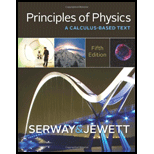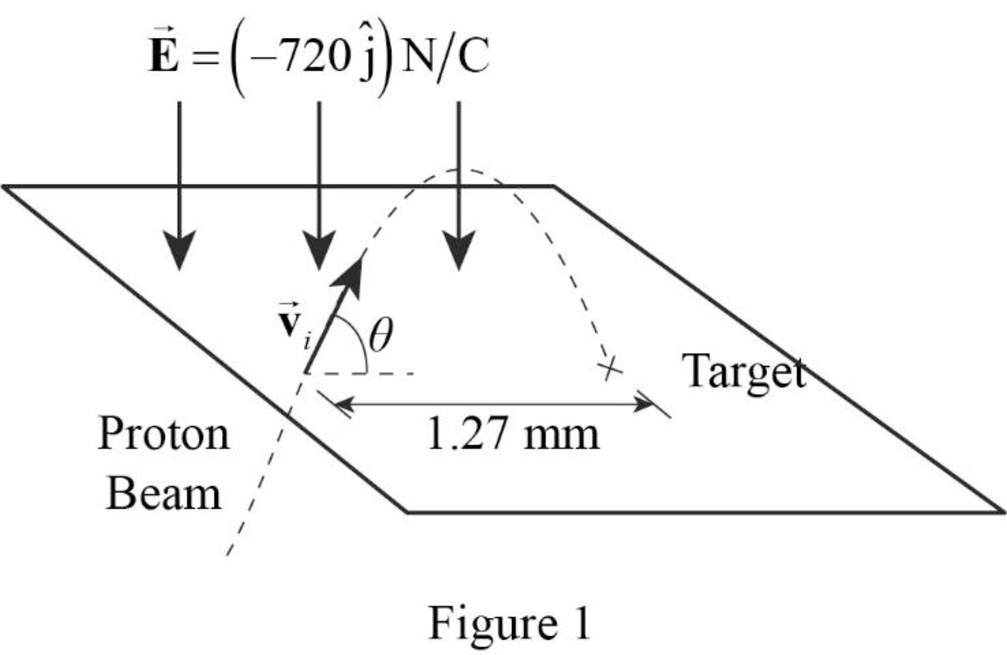
Concept explainers
(a)
The analysis model that describes the horizontal motion of the protons above the plane.
(a)
Answer to Problem 32P
The particle under constant velocity describes the horizontal motion of the protons above the plane.
Explanation of Solution
Figure 1 represents a proton is projected with an angle of

Write the expression for horizontal component of motion of the proton.
Here,
There is no force acting on the proton in the horizontal direction, thus the particle under constant velocity describes the horizontal motion of the protons above the plane.
Conclusion:
Therefore, the particle under constant velocity describes the horizontal motion of the protons above the plane
(b)
The analysis model that describes the vertical motion of the protons above the plane.
(b)
Answer to Problem 32P
The particle under constant acceleration describes the vertical motion of the protons above the plane.
Explanation of Solution
Write the expression for vertical component of motion of the proton.
Here,
From the above equation it is clear that the vertical component of the velocity depends only on acceleration due to gravity. The acceleration due to gravity has a constant value throughout the motion, thus the particle under constant acceleration describes the vertical motion of the protons above the plane.
Conclusion:
Therefore, the particle under constant acceleration describes the vertical motion of the protons above the plane.
(c)
Whether the Equation 3.16 be applicable to the protons.
(c)
Answer to Problem 32P
Yes, the Equation 3.16 is applicable to the protons. The proton moves in a parabolic path.
Explanation of Solution
Given that the electric field is
The vertical acceleration caused by the constant electric force
This vertical acceleration makes the proton to move in a parabolic path, this is similar to a projectile in a gravitational field.
Conclusion:
Therefore, the Equation 3.16 is applicable to the protons. The proton moves in a parabolic path.
(d)
The expression for range
(d)
Answer to Problem 32P
The expression for range
Explanation of Solution
Write the expression for vertical acceleration.
Here,
Write the expression for range from Equation 3.16.
Here,
Since the vertical acceleration is greater than acceleration due to gravity, consider vertical acceleration in the place of acceleration due to gravity.
Apply the above condition in equation (II)
Conclusion:
Substitute
Therefore, the expression for range
(e)
The two possible values of the angle
(e)
Answer to Problem 32P
The two possible values of the angle
Explanation of Solution
From subpart (d) the expression for range
Given that the range is
Conclusion:
Substitute
The other value of
Therefore, the two possible values of the angle
(f)
The time interval during which the proton is above the plane for the two possible values of
(f)
Answer to Problem 32P
The time interval during which the proton is above the plane for the two possible values of
Explanation of Solution
Write the expression for time interval.
Here,
Conclusion:
Substitute
Substitute
Therefore, the time interval during which the proton is above the plane for the two possible values of
Want to see more full solutions like this?
Chapter 19 Solutions
Bundle: Principles of Physics: A Calculus-Based Text, 5th + WebAssign Printed Access Card for Serway/Jewett's Principles of Physics: A Calculus-Based Text, 5th Edition, Multi-Term
- An electron with a speed of 3.00 106 m/s moves into a uniform electric field of magnitude 1.00 103 N/C. The field lines are parallel to the electrons velocity and pointing in the same direction as the velocity. How far does the electron travel before it is brought to rest? (a) 2.56 cm (b) 5.12 cm (c) 11.2 cm (d) 3.34 m (e) 4.24 marrow_forwardA proton is released from rest at the origin in a uniform electric field in the positive x direction with magnitude 850 N/C. What is the change in the electric potential energy of the protonfield system when the proton travels to x = 2.50 m? (a) 3.40 1016 J (b) 3.40 1016 J (c) 2.50 1016 J (d) 2.50 1016 J (e) 1.60 1019 Jarrow_forwardA Figure P23.65 shows two identical conducting spheres, each with charge q, suspended from light strings of length L. If the equilibrium angle the strings make with the vertical is , what is the mass m of the spheres? Figure P23.65arrow_forward
- An electric dipole is located along the y axis as shown in Figure P24.48. The magnitude of its electric dipole moment is defined as p = 2aq. (a) At a point P, which is far from the dipole (r a), show that the electric potential is V=kepcosr2 (b) Calculate the radial component Er and the perpendicular component E of the associated electric field. Note that E = (1/r)(V/). Do these results seem reasonable for (c) = 90 and 0? (d) For r = 0? (e) For the dipole arrangement shown in Figure P24.48, express V in terms of Cartesian coordinates using r = (x2 + y2)1/2 and cos=y(x2+y2)1/2 (f) Using these results and again taking r a, calculate the field components Ex and Ey. Figure P24.48arrow_forwardA Two positively charged particles, each with charge Q, are held at positions (a, 0) and (a, 0) as shown in Figure P23.73. A third positively charged particle with charge q is placed at (0, h). a. Find an expression for the net electric force on the third particle with charge q. b. Show that the two charges Q behave like a single charge 2Q located at the origin when the distance h is much greater than a. Figure P23.73 Problems 73 and 74.arrow_forwardA point charge of 4.00 nC is located at (0, 1.00) m. What is the x component of the electric field due to the point charge at (4.00, 2.00) m? (a) 1.15 N/C (b) 0.864 N/C (c) 1.44 N/C (d) 1.15 N/C (e) 0.864 N/Carrow_forward
- One end of a light spring with force constant k = 125 N/m is attached to a wall, and the other end to a metal block with charge qA = 2.00 C on a horizontal, frictionless table (Fig. P23.34). A second block with charge qB = 3.60 C is brought close to the first block. The spring stretches as the blocks attract each other so that at equilibrium, the blocks are separated by a distance d = 12.0 cm. What is the displacement x of the spring? Figure P23.34arrow_forwardA Van de Graaff generator is charged so that a proton at its surface accelerates radially outward at 1.52 1012 m/s3. Find (a) the magnitude of the electric force on the proton at that instant and (b) the magnitude and direction of the electric field at the surface of the generator.arrow_forwardA proton is located at the origin, and a second proton is located on the x-axis at x = 6.00 fm (1 fm = 10-15 m). (a) Calculate the electric potential energy associated with this configuration. (b) An alpha particle (charge = 2e, mass = 6.64 1027 kg) is now placed at (x, y) = (3.00, 3.00) fm. Calculate the electric potential energy associated with this configuration. (c) Starting with the three-particle system, find the change in electric potential energy if the alpha particle is allowed to escape to infinity while the two protons remain fixed in place. (Throughout, neglect any radiation effects.) (d) Use conservation of energy to calculate the speed of the alpha particle at infinity. (e) If the two protons are released from rest and the alpha panicle remains fixed, calculate the speed of the protons at infinity.arrow_forward
- (a) Find the magnitude and direction of the electric field at the position of the 2.00 C charge in Figure P13.13. (b) How would the electric field at that point be affected if the charge there were doubled? Would the magnitude of the electric force be affected?arrow_forwardA proton is projected in the positive x direction into a region of a uniform electric field E = (6.00 105)iN/C at t = 0. The proton travels 7.00 cm as it comes to rest. Determine (a) the acceleration of the proton. (b) its initial speed, and (c) the time interval over which the proton comes to rest.arrow_forwardA circular ring of charge with radius b has total charge q uniformly distributed around it. What is the magnitude of the electric field at the center of the ring? (a) 0 (b) keq/b2 (c) keq2/b2 (d) keq2/b (e) none of those answersarrow_forward
 Principles of Physics: A Calculus-Based TextPhysicsISBN:9781133104261Author:Raymond A. Serway, John W. JewettPublisher:Cengage Learning
Principles of Physics: A Calculus-Based TextPhysicsISBN:9781133104261Author:Raymond A. Serway, John W. JewettPublisher:Cengage Learning Physics for Scientists and Engineers: Foundations...PhysicsISBN:9781133939146Author:Katz, Debora M.Publisher:Cengage Learning
Physics for Scientists and Engineers: Foundations...PhysicsISBN:9781133939146Author:Katz, Debora M.Publisher:Cengage Learning Physics for Scientists and Engineers with Modern ...PhysicsISBN:9781337553292Author:Raymond A. Serway, John W. JewettPublisher:Cengage Learning
Physics for Scientists and Engineers with Modern ...PhysicsISBN:9781337553292Author:Raymond A. Serway, John W. JewettPublisher:Cengage Learning Physics for Scientists and Engineers, Technology ...PhysicsISBN:9781305116399Author:Raymond A. Serway, John W. JewettPublisher:Cengage Learning
Physics for Scientists and Engineers, Technology ...PhysicsISBN:9781305116399Author:Raymond A. Serway, John W. JewettPublisher:Cengage Learning College PhysicsPhysicsISBN:9781285737027Author:Raymond A. Serway, Chris VuillePublisher:Cengage Learning
College PhysicsPhysicsISBN:9781285737027Author:Raymond A. Serway, Chris VuillePublisher:Cengage Learning





